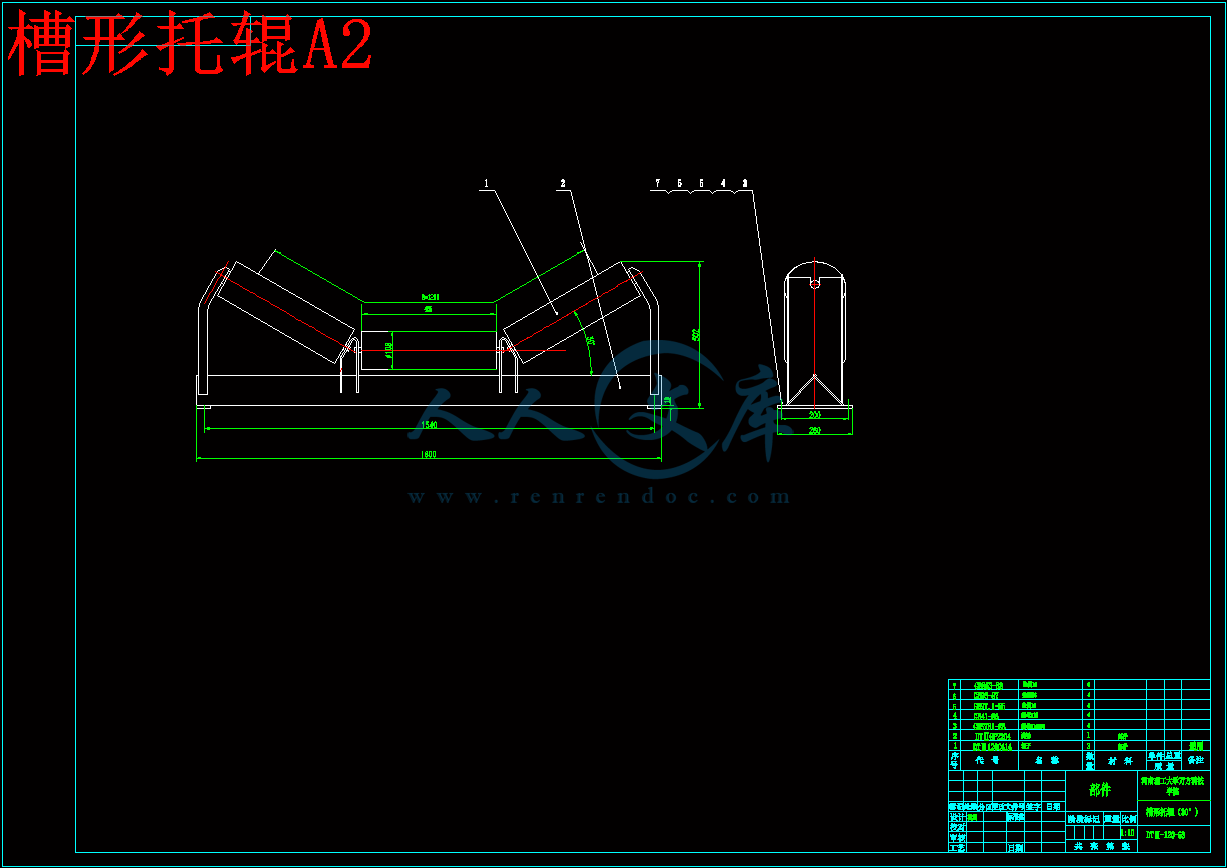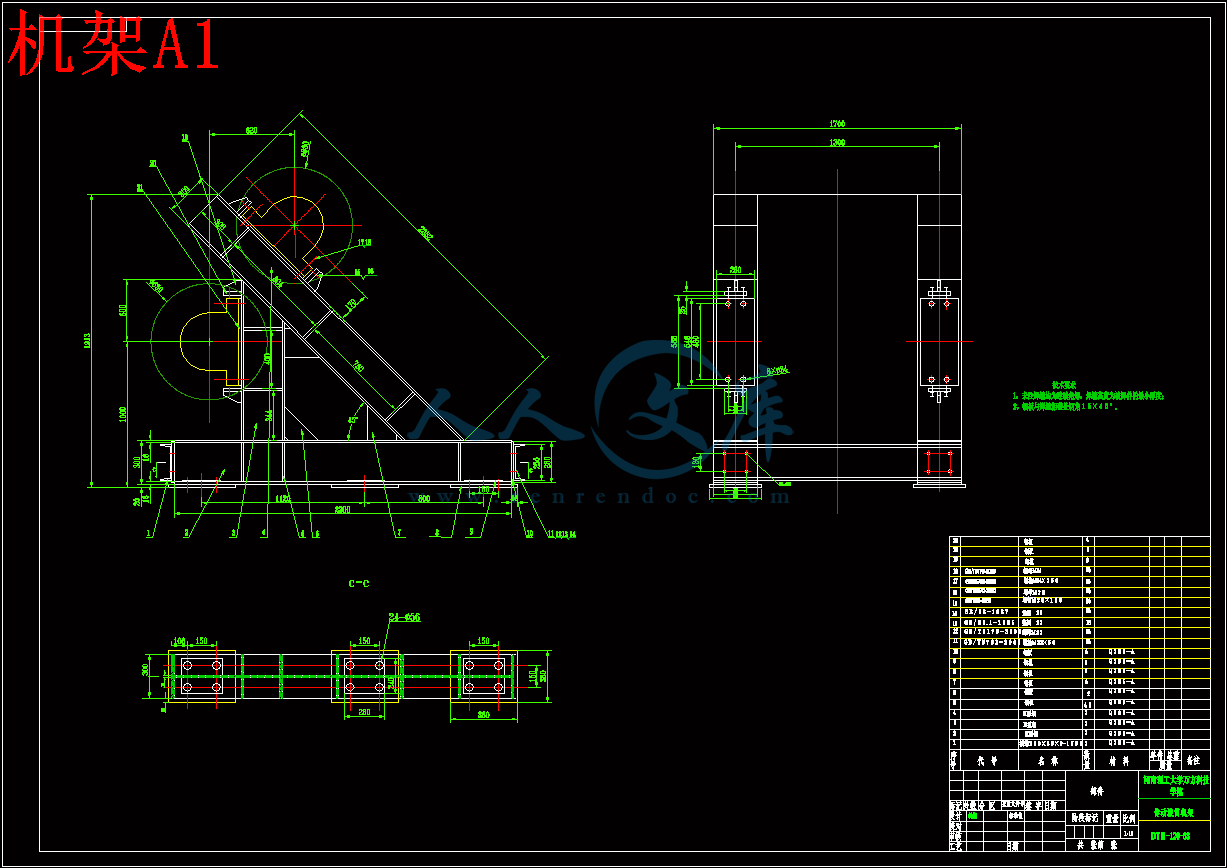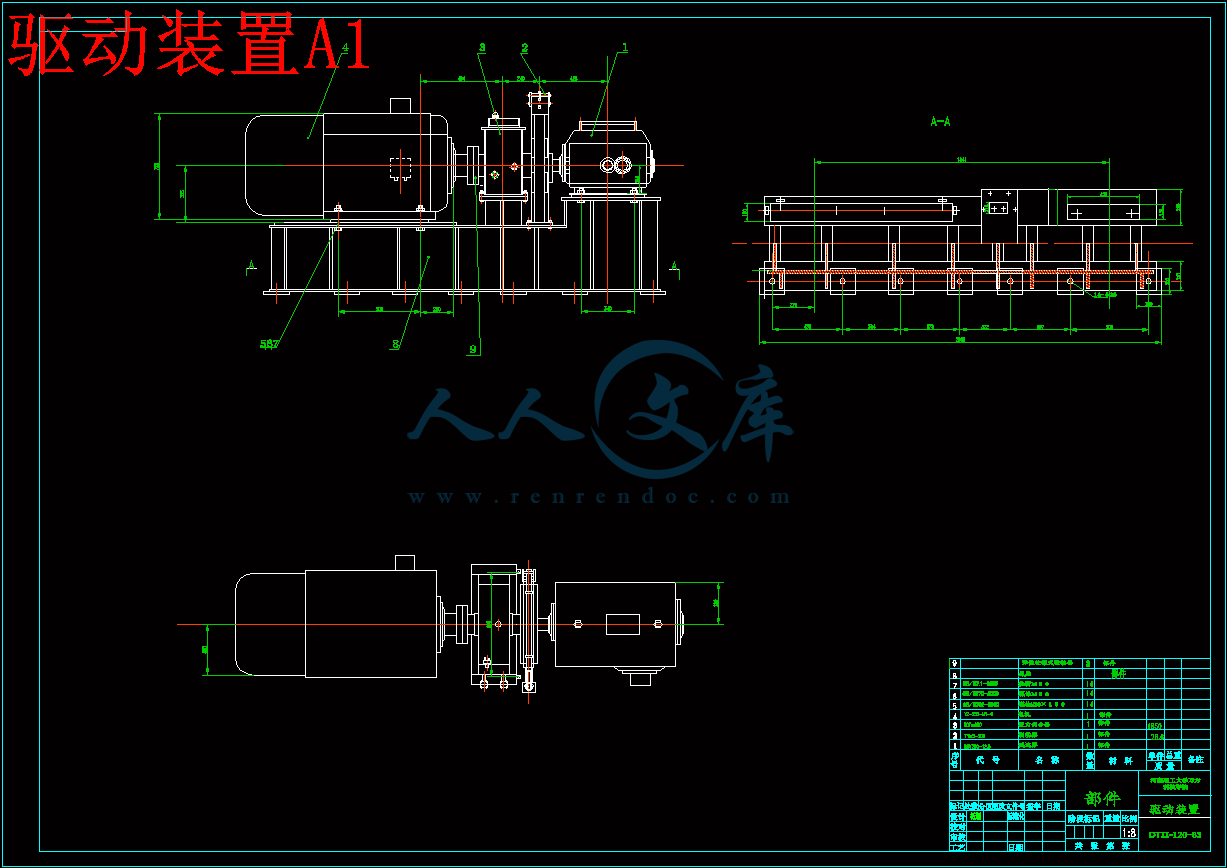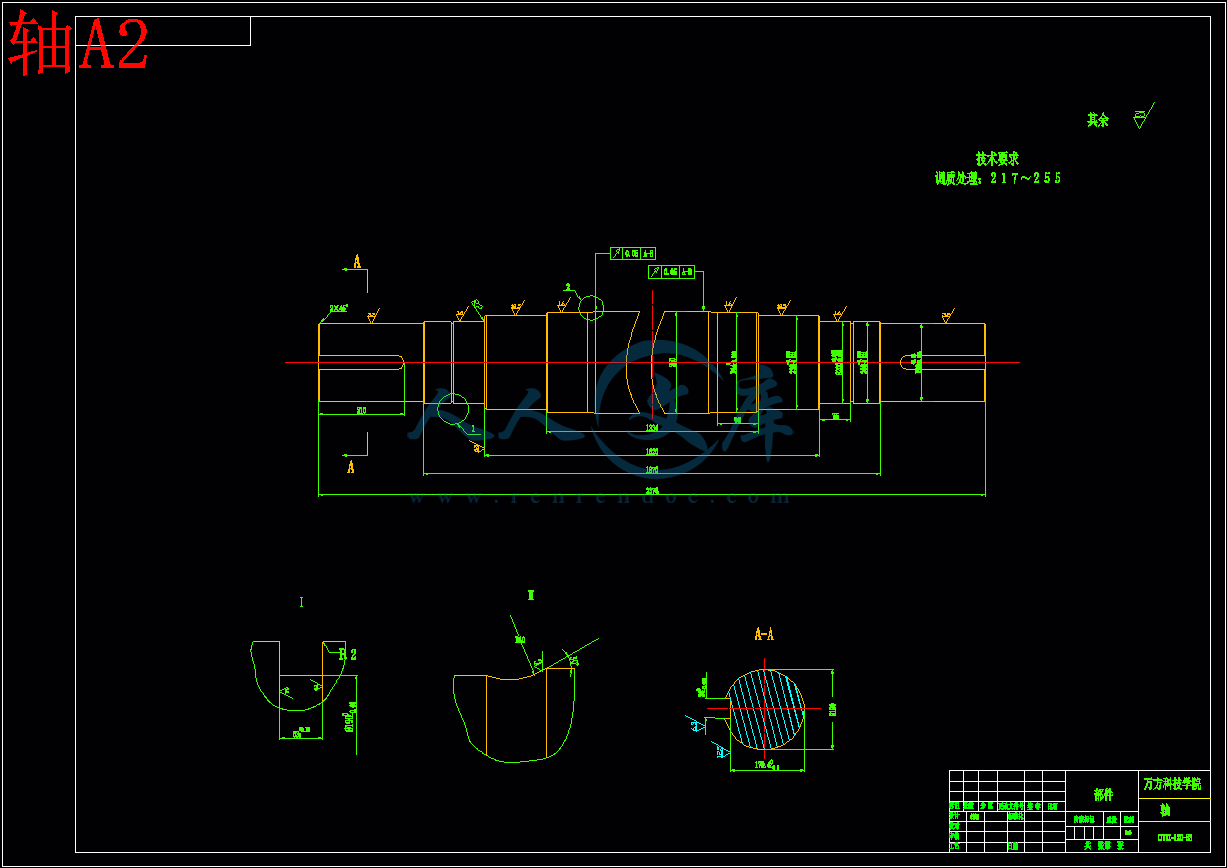带式输送机设计(1200吨每小时)
73页 26000字数+说明书+外文翻译+开题报告+5张CAD图纸
中期报告.doc
外文翻译--煤矿业带式输送机几种软起动方式的比较.doc
带式输送机设计(1200吨每小时)开题报告.doc
带式输送机设计(1200吨每小时)说明书.doc
总装配A0.dwg
机架A1.dwg
槽形托辊A2.dwg
轴A2.dwg
驱动装置A1.dwg
摘 要
本次毕业设计是关于DTⅡ型固定式带式输送机的设计。首先对胶带输送机作了简单的概述;接着分析了胶带输送机的选型原则及计算方法;然后根据这些设计准则与计算选型方法按照给定参数要求进行选型设计;接着对所选择的输送机各主要零部件进行了校核。普通型带式输送机由六个主要部件组成:传动装置,机尾或导回装置,中部机架,拉紧装置以及胶带。最后简单的说明了输送机的安装与维护。目前,胶带输送机正朝着长距离,高速度,低摩擦的方向发展,近年来出现的气垫式胶带输送机就是其中的一个。在胶带输送机的设计、制造以及应用方面,目前我国与国外先进水平相比仍有较大差距,国内在设计制造带式输送机过程中存在着很多不足。
本次带式输送机设计代表了设计的一般过程, 对今后的选型设计工作有一定的参考价值。
关键词:带式输送机 传动装置 导回装置
Abstract
The design is a graduation project about the belt conveyor. At first, it is introduction about the belt conveyor. Next, it is the principles about choose component parts of belt conveyor. After that the belt conveyor abase on the principle is designed. Then, it is checking computations about main component parts. The ordinary belt conveyor consists of six main parts: Drive Unit, Jib or Delivery End, Tail Ender Return End. Intermediate Structure, Loop Take-Up and Belt. At last, it is explanation about fix and safeguard of the belt conveyor. Today, long distance, high speed, low friction is the direction of belt conveyor’s development. Air cushion belt conveyor is one of them. At present, we still fall far short of abroad advanced technology in design, manufacture and using. There are a lot of wastes in the design of belt conveyor.
Keywords: the belt conveyor Drive Unit Delivery End
目 录
前言1
1 绪论3
1.1 带式输送机发展概况3
1.2带式输送机的应用3
1.3带式输送机的分类4
1.4 各种带式输送机的特点5
1.5 矿用带式输送机发展方向6
2 固定式带式输送机8
2.1带式输送机的工作原理8
2.2带式输送机的结构和布置形式10
2.2.1 带式输送机的结构10
2.2.2 布置方式11
2.2.3 运行阻力的计算12
3 带式输送机的设计计算15
3.1 已知原始数据及工作条件15
3.2 计算步骤15
3.2.1 带速和槽角的确定:15
3.2.2 驱动装置18
3.2.3承载段运行阻力21
3.2.4最小张力点23
3.2.5输送点上各点张力的计算23
3.2.6用摩擦条件验算传动滚筒分离点与相遇点张力关系24
3.2.7输送带的强度验算25
3.2.8传动滚筒直径的确定和滚筒强度的验算27
3.2.9拉紧装置28
4 驱动装置的选用31
4.1 电机的选用31
4.2 减速器的选用32
4.2.1传动装置的总传动比32
4.2.2 液力偶合器32
4.2.3 联轴器33
5 带式输送机部件的选用38
5.1 输 送 带38
5.1.1 输送带的分类:38
5.1.2 输送带的连接40
5.2 传动滚筒41
5.2.1 传动滚筒的作用及类型41
5.2.2 传动滚筒的选型及设计42
5.2.3传动滚筒结构及设计43
5.2.4传动滚筒轴的结构设计46
5.3 托 辊49
5.3.1 托辊的作用与类型49
5.3.2 托辊的选型53
5.4 制 动 装 置55
5.4.1 制动装置的作用及种类55
5.4.2 制动装置的选型57
5.5 改 向 装 置58
6 其他部件的选用59
6.1 机架与中间架59
6.2 给 料 装 置61
6.2.1 对给料装置的基本要求61
6.2.2 装料点的缓冲62
6.3 卸料装置63
6.4 清 扫 装 置64
6.5 头部漏斗65
6.6 电气及安全保护装置66
总结67
致 谢68
参考文献69
(2)输送物料:煤;块度 ;
(3)输送量:;物流密度=1t/
(4)输送机长:;
(5)倾角:
3.2 计算步骤
3.2.1 带速和槽角的确定:
按给定的工作条件,取原煤的堆积角为20°。
带式输送机的最大运输能力计算公式为
式中:——输送量(;
——带速(;
——物流密度;
带速选择原则:
(1)输送量大、输送带较宽时,应选择较高的带速。
(2)较长的水平输送机,应选择较高的带速;输送机倾角愈大,输送距离愈短,则带速应愈低。
(3)物料易滚动、粒度大、磨琢性强的,或容易扬尘的以及环境卫生条件要求较高的,宜选用较低带速。
(4)一般用于给了或输送粉尘量大时,带速可取0.8m/s~1m/s;或根据物料特性和工艺要求决定。
(5)人工配料称重时,带速不应大于1.25m/s。
(6)采用犁式卸料器时,带速不宜超过2.0m/s。
(7)采用卸料车时,带速一般不宜超过2.5m/s;当输送细碎物料或小块料时,允许带速为3.15m/s。
(8)有计量秤时,带速应按自动计量秤的要求决定。
(9)输送成品物件时,带速一般小于1.25m/s。
带速与带宽、输送能力、物料性质、块度和输送机的线路倾角有关.当输送机向上运输时,倾角大,带速应低;下运时,带速更应低;水平运输时,可选择高带速.带速的确定还应考虑输送机卸料装置类型,当采用犁式卸料车时,带速不宜超过3.15m/s.
考虑山上的工作条件取带速为2.5 m/s; 故所选的槽形物料断面面积
通过这一环节的训练,提高了以下能力:
(1) 、综合运用所学知识和技能,独立分析和解决实际问题的能力;
(2) 、综合运用各种基本技能,包括绘图、计算机应用、翻译、查阅及阅读文献等等的能力;
(3)、调动实验研究的积极性,技术经济分析和组织协作工作的能力,学习撰写科技论文和技术报告,正确运用国家标准和技术语言阐述理论和技术问题的能力;
(4)、学会收集加工各种信息的能力,以及获取新知识的能力;
(5)、培养创新意识和严肃认真的科学作风。
毕业设计在我们的大学学习中占据着举足轻重的地位,我们应该抓紧这个机会认真学习并做好毕业设计。因为它对我们进入实践及将来参加工作有重要的意义,也是为我们这四年的大学学习画上一个圆满的句号,是检验我们学习成果的试金石,它将把我们过去的理论学习引向一个更高的层次,也就是联系实践,可以说我们在做一次实践性的实验。因此在思想和行动上我们都要对毕业设计表现出极大的重视,并努力认真去完成。
在设计过程中,遇到了很多难题,一方面我们自己查阅相关资料、共同讨论,同时,还感谢多位老师和工厂工程师的大力支持,他们有问必答,耐心讲解,悉心指导,在此表示衷心的感谢。
1 绪论
1.1 带式输送机发展概况
带式输送机自1795年被发明以来,经过两个世纪的发展,已被电力、冶金、煤炭、化工、矿山、港口等各行各业广泛采用。特别是第三次工业革命带来了新材料、新技术的应用,使带式输送机的发展步入了一个新纪元。
如今,无论从输送量、运距、经济效益等各方面来衡量,它已经可以和火车、汽车运输相抗衡,成为三足鼎立的局面,并成为各国争相发展的行业。带式输送机是以胶带、钢带、钢纤维带、塑料带和化纤做为传送物料和牵引工具的输送机械。其特点是承载物料的输送带也是传递动力的牵引力。承载带在托辊上运行,也可用气垫、磁垫代替托辊作为无阻力支撑承载带运行。带式输送机按承载断面可分为平形、槽形、双槽形、波纹挡边斗式、波纹挡边袋式、吊挂式圆管形、固定式和移动式圆管形等8大类。
带式输送机是煤矿最理想的高效连接运输设备,它与其它运输设备(如机车类)相比,不仅具有长距离、大运量、连续输送等优点,而且运行可靠,易于实现自动化、集中化控制,特别是对高产高效矿井,带式输送机已成为煤炭高效开采机电一体化技术与装备的关键设备。目前,我国煤矿共用带式输送机约120万台,矿用带式机也正在往大运量、长距离、高带速方向发展。
1.2带式输送机的应用
带式输送机是连续运输机的一种,连续运输机是固定式或运移式起重运输机中主要类型之一,其运输特点是形成装载点到装载点之间的连续物料流,靠连续物料流的整体运动来完成物流从装载点到卸载点的输送。在工业、农业、交通等各企业中,连续运输机是生产过程中组成有节奏的流水作业运输线不可缺少的组成部分。
连续运输机可分为:
(1)具有挠性牵引物件的输送机,如带式输送机,板式输送机,刮板 输送机,斗式输送机、自动扶梯及架空索道等;
(2)不具有挠性牵引物件的输送机,如螺旋输送机、振动输送机等;
(3)管道输送机(流体输送),如气力输送装置和液力输送管道.
其中带输送机是连续运输机中是使用最广泛的, 带式输送机运行可靠,输送量大,输送距离长,维护简便,适应于冶金煤炭,机械电力,轻工,建材,粮食等各个部门。
1.3带式输送机的分类
带式输送机分类方法有多种,按运输物料的输送带结构可分成两类,一类是普通型带式输送机,这类带式输送机在输送带运输物料的过程中,上带呈槽形,下带呈平形,输送带有托辊托起,输送带外表几何形状均为平面;另外一类是特种结构的带式输送机,各有各的特点.其简介如下:
1.4 各种带式输送机的特点
⑴ QD80轻型固定式带输送机 QD80轻型固定式带输送机与TDⅡ型相比,其带较薄、载荷也较轻,运距一般不超过100m,电机容量不超过22kw.
⑵ 它属于高强度带式输送机,其输送带的带芯中有平行的细钢绳,一台运输机运距可达几公里到几十公里.
⑶ U形带式输送机 它又称为槽形带式输送机,其明显特点是将普通带式输送机的槽形托辊角由提高到使输送带成U形.这样一来输送带与物料间产生挤压,导致物料对胶带的摩擦力增大,从而输送机的运输倾角可达25°.
⑷ 管形带式输送机 U形带式输送带进一步的成槽,最后形成一个圆管状,即为管形带式输送机,因为输送带被卷成一个圆管,故可以实现闭密输送物料,可明显减轻粉状物料对环境的污染,并且可以实现弯曲运行.
⑸ 气垫式带输送机 其输送带不是运行在托辊上的,而是在空气膜(气垫)上运行,省去了托辊,用不动的带有气孔的气室盘形槽和气室取代了运行的托辊,运动部件的减少,总的等效质量减少,阻力减小,效率提高,并且运行平稳,可提高带速.但一般其运送物料的块度不超过300mm.增大物流断面的方法除了用托辊把输送带强压成槽形外,也可以改变输送带本身,把输送带的运载面做成垂直边的,并且带有横隔板,一般把垂直侧挡边作成波状,故称为波状带式输送机,这种机型适用于大倾角,倾角在30°以上,最大可达90°.
(6)压带式带输送机 它是用一条辅助带对物料施加压力.这种输送机的主要优点是:输送物料的最大倾角可达90°,运行速度可达6m/s,输送能力不随倾角的变化而变化,可实现松散物料和有毒物料的密闭输送.其主要缺点是结构复杂、输送带的磨损增大和能耗较大。
⑺ 钢绳牵引带式输送机 它是无际绳运输与带式运输相结合的产物,既具有钢绳的高强度、牵引灵活的特点,又具有带式运输的连续、柔性的优
1.5 矿用带式输送机发展方向
(1)大型化、提高运输能力
为了适应高产高效集约化生产的需要,带式输送机的输送能力要加大,长距离、高带速、大运量、大功率是将来发展的必要。在今后10 年内输送能力要提高到3000 ~10000 t/h,带速提高至5~8m / s,输送长度对于可伸缩带式输送机输送距离要达到6000m以上,对于钢绳芯强力带式输送机须达到14000m以上,单台电机功率要达到1000~2500kW 以上,输送带抗拉强度大于6000N /mm(钢绳芯)和3150N /mm (整芯) 。
(2) 提高元部件性能和可靠性
整体设备的性能和可靠性主要取决于元部件的性能和可靠性,我国现在的矿用带式输送机的元部件基本上都是各自厂家生产,还没有出现专业化、大规模的元部件生产厂家。除了进一步完善和提高现有元部件的性能和可靠性,还要不断研究新的技术和开发新的元部件。
(3) 扩大功能,一机多用
带式输送机是一种理想的连续运输设备,并且目前还不能完全发挥其全部作用。可以将带式输送机结构作适当修改,采取一定的安全措施,就可拓展运人、运料或双向运输等功能,做到一机多用,使其发挥最大经济效益。
(4) 开发专用机型
我国煤矿的地质条件差异很大,在运输系统的布置上经常会出现一些特殊要求,为了满足特殊要求,比如水平拐弯、大倾角(>25o)直至垂直提升等,这些场合常规的带式输送机是无法胜任的。为了满足煤矿的某些特殊要求,应开发特殊型带式输送机,如弯曲带式输送机、大倾角或垂直提升输送机等。
参考文献
[1] 程居山.矿山机械.徐州:中国矿业大学出版社,1997;
[2] 机械设计手册编写组.机械设计手册.化学工业出版社,1987;
[3] 方慎权.煤矿机械.徐州:中国矿业学院出版社,1986;
[4] 潘英.通用机械设计.徐州:中国矿业大学出版社,2002;
[5] 孔庆华,刘传绍.极限测量与测试技术基础.同济大学出版社,2002;
[6] 唐大放,冯晓宁.杨现卿.机械设计工程学.徐州:中国矿业大学出版社,2001;
[7] 机械电子工业部编.机械产品目录8.机械工业出版社,1991;
[8] 中国纺织大学工程图学教研室.画法几何及工程制图.上海科技出版社,2000;
[9] 焦作矿业学院,煤矿机械传动设计,煤炭工业出版社,1979;
[10] 候志学,矿山运输机械,冶金工业出版社,1996;
[11] 纪名贵,机械设计,高等教育出版社,2004。





 川公网安备: 51019002004831号
川公网安备: 51019002004831号